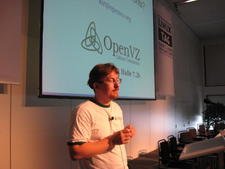LinuxTag 2009: Resource Management with OpenVZ
OpenVZ project leader Kir Kolyshkin clarified at LinuxTag 2009 that the software also lends itself to Linux resource management.
The facts are clear, Koyshkin said at the outset: every computer has but finite resources such as CPU time, memory, hard disk size and I/O, and network I/O. Administrators are interested in protecting these resources from DoS attacks so that they can continue providing QoS or simple processing.
The Linux kernel already provides resource management tools, said Kolyshkin: disk quotas, nice and renice, the real-time priority queue and limits on CPU time with ulimit -c. Ulimit alone controls 16 different parameters. However, Kolyshkin doesn't find this pallet to be enough. Some limits can't be set and the others are done so at login and can't subsequently be regulated. This is where Kolyshkin brought OpenVZ into the picture. The software allows creating multiple isolated userspace instances, called containers, on a single kernel. Webhosters, for example, could use these containers for their services. From a resource management viewpoint, containers are simply groups of processes.

OpenVZ brings its own resource control mechanisms, called beancounters, that have access to 20 parameters modifiable for process groups at runtime. These groups can be containers, users or applications. For example, the Apache 2 webserver has many processes that could more sensibly combined into application groups. OpenVZ categorizes these user beancounters (UBCs) on its wiki page.
Kolyshkin revealed that further mainline kernel control mechanisms are available through control groups (cgroups) developed over the years by the big iron folks at Bull and SGI. Paul Menage was responsible for bringing cgroups into the Linux kernel for grouping processes for binding memory controllers. Cgroups, however, don't offer as many features as OpenVZ's beancounters, although Kolyshkin wishes for future OpenVZ features such as shared pages accounting, I/O priorities per cgroup and checkpoint/recreate. The latter freezes the state of a group and is used by container or virtualization software such as OpenVZ and Xen for live migration. Further details are in the /usr/src/linux/Documentation/cgroups/* and /controllers/* directories of the kernel source code.
Kolyshkin would love to see the OpenVZ container features integrated into the mainline kernel, but that will "take years." But he's thinking of the future: integration of checkpoint/recreate in the official Linux kernel.
Subscribe to our Linux Newsletters
Find Linux and Open Source Jobs
Subscribe to our ADMIN Newsletters
Support Our Work
Linux Magazine content is made possible with support from readers like you. Please consider contributing when you’ve found an article to be beneficial.

News
-
Two New Distros Adopt Enlightenment
MX Moksha and AV Linux 25 join ranks with Bodhi Linux and embrace the Enlightenment desktop.
-
Solus Linux 4.8 Removes Python 2
Solus Linux 4.8 has been released with the latest Linux kernel, updated desktops, and a key removal.
-
Zorin OS 18 Hits over a Million Downloads
If you doubt Linux isn't gaining popularity, you only have to look at Zorin OS's download numbers.
-
TUXEDO Computers Scraps Snapdragon X1E-Based Laptop
Due to issues with a Snapdragon CPU, TUXEDO Computers has cancelled its plans to release a laptop based on this elite hardware.
-
Debian Unleashes Debian Libre Live
Debian Libre Live keeps your machine free of proprietary software.
-
Valve Announces Pending Release of Steam Machine
Shout it to the heavens: Steam Machine, powered by Linux, is set to arrive in 2026.
-
Happy Birthday, ADMIN Magazine!
ADMIN is celebrating its 15th anniversary with issue #90.
-
Another Linux Malware Discovered
Russian hackers use Hyper-V to hide malware within Linux virtual machines.
-
TUXEDO Computers Announces a New InfinityBook
TUXEDO Computers is at it again with a new InfinityBook that will meet your professional and gaming needs.
-
SUSE Dives into the Agentic AI Pool
SUSE becomes the first open source company to adopt agentic AI with SUSE Enterprise Linux 16.
